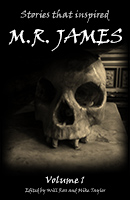 Ahoy there listeners! Be grabbin’ yer nautical gear for a cruise on the high seas of Leicestershire, with LTC Rolt and his story Bosworth Summit Pound. (Enough. It’s set on a canal – ed) What terrors might await us on England’s peaceful inland waterways? And just who digs a canal tunnel under an ancient graveyard anyway?
Ahoy there listeners! Be grabbin’ yer nautical gear for a cruise on the high seas of Leicestershire, with LTC Rolt and his story Bosworth Summit Pound. (Enough. It’s set on a canal – ed) What terrors might await us on England’s peaceful inland waterways? And just who digs a canal tunnel under an ancient graveyard anyway?
Story notes
- Thank you to our reader this week Tony Walker: you must check out his Classic Ghost Stories podcast and episode on this story. If you’d like to know more about his podcast, make sure you listen through to the end of our show for an exclusive trailer from Tony!
- Tom Rolt built Spitfires during WW2, and in 1944 had his first book ‘Narrow Boat’ published. It was a big success, and through it he made connections with the people with whom he would form the Inland Waterways Association, an organisation dedicated to preserving Britain’s canals and other waterways. He was actually expelled from this in 1951 after falling out with founding member (and fellow author of supernatural fiction) Robert Aickman (see this amusing plaque, which suggests the enmity lingered after both their deaths!).
- Rolt’s one volume of ghost stories ‘Sleep No More’ was published in 1948. Mike Ashley wrote of this, “Rolt had a formidable knowledge of the byways, waterways and railways of Britain which made Sleep No More (1948) a most unique volume of the supernatural”. Ashley adds that of MR James’s imitators, “Malden, Munby and Rolt achieve the most success in blending James’s techniques with their own narratives… Because of his ability to utilise original surroundings, L.T.C. Rolt’s stories are perhaps the most refreshing.”
- In another essay worth reading, Kai Roberts wrotes that “Rolt succeeds because the industrial setting he evokes is one about which he is passionate and knowledgeable.”
Podcast: Play in new window | Download
Subscribe: RSS








Perhaps they couldn’t easily separate the bodies so they buried them together. It seems unlikely that the posher family would allow such a thing. It would also have been helpful to give John a reason to be down by the canal.
The writing is good however and I very much enjoyed the story, even though the plot doesn’t quite work.
Agh why didn’t we think of that? I sometimes think we should get everyone’s comments on each *before* we record the show!
The two bodies being (literally) inseparable in death was my interpretation behind the shared burial (on the north side of the church) as well.
I assumed the ghost of Mary had tormented or scared John in a similar fashion to ‘A School Story’ (using someone as a medium to write eerie notes in a ‘I Know What You Did Last Summer’ fashion), or ‘Martin’s Close’, where the ghost appears and scares Squire Martin – John may have wanted to see if the body of Mary was really where he had dumped her, or if someone had seen him murder her and dispose of the body and was messing with him.
Very much a fan of this story – the unique setting and the nods to the antiquarian ghost story works really well. Rolt is really good at making the canal scenes come to life and putting more emphasis on these beautiful descriptions of the surroundings. I do think James would have gone for an even more effective ‘wallop’ than Rolt.
That being said, the visual of Mary rising from the canal water at night is quite eerie, and it brought to mind the Theodor Kittelsen painting ‘Nøkken’ from 1904, depicting the Nix rising from the tarn, and the surroundings mirrored in the still surface similar to the scene in this story.
I think his being by the tunnel entrance is due to a practical interest as to whether the body was still hidden or maybe due to remorse and contemplating his deed. I read this story years ago and although it is a cross between a School Story and Martin’s Close , I think it works well.
The canal setting of this story reminded me of ‘Three Miles Up’ by Elizabeth Jane Howard.
Absolutely love your podcast. Over the past year, I’ve read the stories and then listened to the podcast for each one. It’s been a pleasure to have a bright spot over this time of covid. I’ve managed to listen to almost all of the episodes.
I wanted to share that I found the story online in case others would like to read prior or along with the Classic Ghost Stories podcast episode: http://jayrothermel.blogspot.com/2017/02/in-death-undivided-ltc-rolts-story.html
Thanks very much for adding background and depth from your discussions of these ghostly tales. I hope you will keep more coming.
Aww, John was reunited with Mary on Valentine’s Day. How sweet.
I didn’t get the impression John had killed Mary, actually. He seems upset at her disappearance and then his ghost is looking in the canal for something he fears is there. Instead I think his family did it, which turns it into a tragedy where the couple are victims of the time and circumstances. Mary probably had no idea John had been barred from seeing her, and no one can blame her for being furious at what she sees as a faithless lover left to care for a child by herself. Mary being of Gypsy extraction is simply a convenient excuse as to why she vanished. I do like to think he was in love with her, and that’s just me, because we know next to nothing about the relationship aside from suppositions from other people (the idea of her being a burden being such). There’s also the mother, who I have a feeling called up the ghost of her daughter, to fulfill some promise or something, or to see the relationship into a grim and unnatural fruition. Ultimately I think there’s a whole story we’re just not privy to.
I did like it, though, it’s not revolutionary, but it’s effective. A nice little ghost story. The description of Mary’s ghost was great, and the veil-like hair over the face was very Japanese ghost in style, which is a good look.
Nice pick up about Japanese styled ghost. I hadn’t though of that. When the description was given of hair, I though it had a Jamesian feel to it…as he often has references to hair in the description of his creatures.
Hi. Love, love the podcast and have for years! Sorry about the following’s “academic” tone, lol. The discussion of Power in the short story, with John holding all the Power and Mary as Powerless, is intriguing. The sentence in question, “…but this did not prevent young John Lofthouse from falling a victim to her dark good looks,” demonstrates Mary flexing agency, rather than being a mere pawn to the exploitation of higher economic classes. It becomes problematic to take her agency away with claims of John’s somehow automatic Power over her simply because he has more economic power/value.
The presumption of centering Power, a single Power that rules over all humanity, in economic value seems to contradict the very heart of ghost stories. At heart, ghost stories are demonstrations of the multi-directional flows of Power, i.e. the non-hierarchical flows of Power. For, in ghost stories that which traditionally has Power and Agency (the vital, living beings) must give way to that which traditionally has no Power and Agency (the inanimate objects of the world, including the inanimate, dead body). At heart, ghost stories disrupt outdated hierarchical models of top-down power, and demonstrate the wild, tangled knot of how Power actually flows through our lives: in an endless dance of infinite, multidirectional flows. The dynamic of Mary’s “aesthetic power” and John’s “economic power” is not a situation in which any given power is in the primary or secondary positions, because Power doesn’t have positionals, it is an unfettered, unceasing buzzing flow (represented by the merging of Mary and John in their final, fatal embrace).
Essentially, the best relationships often occur when each party benefits from the Power provided from the other. Sadly, this was not the case in this story.
You’re forgetting another very important factor – that he was a man and she a woman. That phrase ‘fell victim to her dark good looks’ sounds incredibly misogynistic to me – the equivalent of saying ‘she was wearing a short skirt so he couldn’t help himself, she led him on’. Men had all the power in relationships especially at a time before safe abortion was available- if she was pregnant (which I think is heavily hinted at, if not said explicitly) then she would literally be left holding the baby while he could avoid any responsibility if he so chose; could claim it was another man’s child or whatever. Also of course the average man is larger and more physically powerful than the average woman.
I’m probably not explaining myself very well but it’s definitely not all about economic power.
You explained yourself perfectly well. But I think we all understand that he was a man and she was a woman. It’s not a secret.
Regarding this: That phrase ‘fell victim to her dark good looks’ sounds incredibly misogynistic to me …”
If men being attracted to woman for their appearance is misogyny, then …. well then.Apparently you know no women who have become obsessed by a man. It happens. I’m remineded of the4 women who was caught on video breaking into her ex-boyfriend’s house and cutting and tearing every piece of his clothing. All of them. With gusto.
So to re-iterate, yes, this is 2021 and, being adults we do know about men and women, and no, no every phrase needs to ring a women’s studies bell. If you continue this way, I don’t see how you will be able to read a book written before 2015. Try assuming the best about people – and fictional characters – you’ll enjoy life more.
I must have listened to the story on the Ghost Stories podcast, because I definitely remember it. Those dark, cramped tunnels certainly amke for a scary location. The United States did have some canals built, but not on the level of the UK. I tried to get the book of Rolt stories through my local library and had no luck.
And there’s no ebook available! An outrage!
It can be ordered on Amazon.
I can recommend the Ash Tree Press edition, which is available as an ebook in the UK. Sadly we are moving beyond the authors on our list that are in the public domain. The next author ANL Munby, doesn’t (I think) have a current ebook or paper version – though Tony on the Classic Ghost Story Podcast has done a few of his tales.
Unfortunately there’s no A N L Munby stories on the Classic Ghost Stories Podcast, unless they’re on a patron page inaccessible to freeloaders like me.
I have an Ash Tree Press e book dated 2012 – I must have bought it through Amazon a few years back though can’t remember exactly when. Doesn’t seem available any more which is a shame- seems like a backwards step! My favourite book of the supernatural after MRJ’s volumes.
This is one of my favourite ghost stories along with ‘The Mine’ also by Rolt. It has a very stealthy creepiness about it, plus a historic rural flavour, which draws in the reader right to the end.
It’s been years since I last read the story itself, but FWIW my impression~interpretation was that the woman’s mother was responsible for ‘hexing’ the man into coming back to the canalside where her daughter’s revenant could exact her vengeance.
In any case, I’m really glad to have L.T.C. Rolt covered by the podcast. In some sense I feel like he’s one of the very most “Jamesian” of all “Jamesian” writers, by virtue of his intense personal feeling for an obscure but material (very material) domain of the ‘not too remote’ past haunting, physically, some unwary and perhaps too-curious, isolated, members of the present.
L T C Rolt’s collection of ghost stories “Sleep No More” are a mixed bag. Those that really work rely on his exceptionally detailed knowledge of steam railways, canals, motor cars, and industrial archaeology. It was thanks to him that the Talyllyn Railway Preservation Society came into being back in 1950 – the forerunner of all preserved railways. So, for me “The Garside Fell Disaster”, “Bosworth Summit Pound”, “New Corner” and “Hawley Bank Foundry” are the best of Rolt’s supernatural tales – all very Jamesian. This year (2024) being the fiftieth anniversary of Rolt’s death back in 1974 saw published the first full length biography of him “The Life of L T C Rolt” by Victoria Owens.